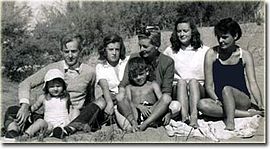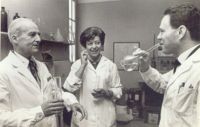Luis Federico Leloir
Luis Federico Leloir (Paris, September 6, 1906-Buenos Aires, December 2, 1987) was an Argentine physician, biochemist, and pharmacist who received the Nobel Prize in Chemistry in 1970 for his research on sugar nucleotides, and the role they play in the manufacture of carbohydrates. After his discovery, the details of the congenital disease galactosemia were fully understood. He was part of Bernardo Houssay's research team.
Biography
Childhood and adolescence
His parents traveled from Buenos Aires to Paris (his mother in an advanced state of pregnancy) in mid-1906 due to the illness that Federico Leloir (father) was suffering from and for which he had to be operated on in a French medical center. On September 6, Luis Federico Leloir was born in an old house on Avenida Victor-Hugo 81 in the French capital and his father would die when he was very young.
Returning to his country of origin in 1908, Leloir lived with his eight siblings on the extensive Pampean lands that their ancestors had bought after their immigration from Spain, 40,000 hectares called El Tuyú, which included the maritime coast from San Clemente del Tuyú to Mar de Ajó.
When he was barely four years old, Leloir learned to read on his own, helped by the newspapers that his relatives bought to stay up to date on agricultural issues. During his early years, he devoted himself to observing all natural phenomena with particular interest, and his readings always pointed to topics related to the natural and biological sciences.
His initial studies were divided between the General San Martín School, where he gave his first year free, the Lacordaire College, the Salvador College and Beaumont College (the latter in England). His grades didn't stand out for good or bad. His first university foray ended quickly when he abandoned the architectural studies he had begun at the Polytechnic Institute of Paris.
One day in 1925, he had lunch with his friends and colleagues in the dining room of the Mar del Plata Golf Club, some seafood accompanied by the traditional sauces and dressings. Luis Federico asked the waiter if he could provide him with some kitchen supplies and after having fun with his friends trying different combinations of sauces, he verified that by mixing equal amounts of mayonnaise and ketchup, along with a little cognac and Tabasco sauce, he obtained an ideal accompaniment to prawns. This is how golf sauce arose, which, named after the place where it was born, would obtain, over time, a place at the Argentine table.
Professional career
Back in Buenos Aires, he entered the Faculty of Medicine of the University of Buenos Aires to obtain a doctorate in said profession. His beginnings were difficult, so much so that he had to take the anatomy exam four times, but in 1932 he was able to graduate and began his activity as a resident at the José de San Martín Hospital de Clínicas and as an intern at the Ramos Mejía Hospital. After some internal conflicts and complications regarding the treatment that he should have with his patients, Leloir decided to dedicate himself to laboratory research.
In 1933 he met Bernardo Houssay, who directed his doctoral thesis on the adrenal glands and carbohydrate metabolism. The meeting was accidental, since Luis Leloir lived only half a block from the house of his cousin, the writer and editor Victoria Ocampo, who was the sister-in-law of gastroenterologist Carlos Bonorino Udaondo, a doctor and friend of Houssay's.
Her thesis, completed in just two years, received the faculty award for best doctoral paper. Together with his teacher, he discovered that his training in sciences such as physics, mathematics, chemistry and biology was scarce, so he began to attend classes in these specialties at the Faculty of Exact and Natural Sciences of the University of Buenos Aires as a listening student..
In 1936 he traveled to England to begin his advanced studies at Cambridge University, under the supervision of Frederick Gowland Hopkins, who had won a Nobel Prize in 1929 for his studies in physiology and medicine after discovering that certain substances, known today as vitamins, they were essential for maintaining good health. His studies at the Cambridge Biochemical Laboratory focused on enzymology, specifically the effect of cyanide and pyrophosphate on succinic dehydrogenase. From this point on, Leloir specialized in carbohydrate metabolism.
Around 1943, Leloir left his position as a researcher at the University of Buenos Aires, in solidarity with his mentor Bernardo Houssay, who had been expelled from that university's Faculty of Medicine for signing a public letter in opposition to the Nazi regime of Germany, at a time when Pedro Pablo Ramírez was de facto president of Argentina and Edelmiro Julián Farrell his minister of war. Leloir's destination was the United States, where he held the position of research associate in the Department of Pharmacology at the University of Washington, in charge of the marriage of Carl and Gerty Cori, with whom Houssay shared the Nobel Prize in 1947. He also shared research with Professor D. E. Green at the Enzyme Research Laboratory, College of Physicians and Surgeons, New York. Before going into exile, he married Amelia Zuberbühler with whom he had four children.
In 1945 he returned to Argentina to work at the Institute run by Bernardo Houssay, the predecessor of the Fundación Campomar Biochemical Research Institute, which Leloir would direct since its creation in 1947 at the hands of businessman Jaime Campomar and for 40 years.
During the late 1940s, Leloir successfully performed experiments that revealed the chemical pathways in the synthesis of sugars in yeast with very low-cost equipment, due to lack of financial resources. Prior to her research, it was believed that in order to study a cell, it could not be disintegrated from the organism that hosted it. However, his work demonstrated that this Pasteurian theory was false.
Since 1947 he formed a working group together with Ranwel Caputto, Enrico Cabib, Raúl Trucco, Alejandro Paladini, Carlos Cardini and José Luis Reissig, with whom he investigated and discovered why the kidney promotes arterial hypertension when it is sick. That same year, his laboratory partner Ranwel Caputto brought up a problem he had in his biological research on the mammary gland, for which his team, which included fellowship holder Alejandro Paladini, succeeded in isolating the nucleotide-sugar substance called uridine diphosphate glucose (UDPG), and therefore understand the process of storing carbohydrates and their transformation into reserve energy.
At the beginning of 1948, Leloir's team identified carnucleotide sugars, compounds that play a fundamental role in the metabolism and metabolic pathway of carbohydrates, which made the Institute a world-renowned center. Immediately afterwards, Leloir received the Argentine Scientific Society Award.
In 1957, with the death of the businessman Campomar, the institute ran out of funds and was tempted by the Rockefeller Foundation and the Massachusetts General Hospital to emigrate to the United States, but, like his teacher Houssay, he preferred to stay and continue working in Argentina. Given its importance, the National Institutes of Health (NIH) and the Rockefeller Foundation decided to subsidize the research led by Leloir since the Argentine government did not show interest in doing so. Help from the Argentine State would come with the creation of the National Council of Scientific and Technical Research (CONICET), in which Leloir was part of its board, with Houssay as president. “Thanks, in large part, to the work of the Council and the drive of many young people, biochemical research has made considerable progress in the country; however, it is small when compared to what happened in the most advanced countries”.
The following year he signed an agreement with the Dean of the Faculty of Exact and Natural Sciences of the University of Buenos Aires, Rolando García, by which the Institute of Biochemical Research of the Faculty of Exact and Natural Sciences was created, appointing professors headlines to Leloir, Carlos Eugenio Cardini and Enrico Cabib. This contributed to attracting young Argentine university students to scientific research, which had an impact on the growth of the institution. Researchers and scholarship holders from the United States, Japan, England, France, Spain and various Latin American countries also came to the center.
By then, Leloir was carrying out his laboratory work in conjunction with teaching as an external professor at the Faculty of Exact and Natural Sciences, a task that he only interrupted to complete his studies at Cambridge and at the Enzyme Research Laboratory in USA.
His desire for research overcame the economic difficulties faced by the Institute. Using homemade tools, Leloir dedicated himself to studying the internal process by which the liver receives glucose and produces glycogen, the body's energy reserve material, and together with Mauricio Muñoz he managed to oxidize fatty acids with liver cell extracts.
In 1968, he obtained the Benito Juárez prize awarded by the Mexican government, an honorary doctorate from the National University of Córdoba and membership of the Pontifical Academy of Sciences of Vatican City by resolution of its members.
In 1970 he was awarded the Nobel Prize in Chemistry, becoming the first Ibero-American to receive it. Subsequently, his team dedicated itself to the study of glycoproteins –recognition molecules in cells– and determined the cause of galactosemia, a serious disease manifested in intolerance to milk. The biochemical transformations of lactose into its own components are known in the scientific world as the Leloir Route. He donated the $80,000 prize to the Leloir Institute to continue his research work.
Death
He died in Buenos Aires on December 2, 1987 at the age of 81, after a heart attack shortly after arriving home from the laboratory.
He was buried in the Recoleta Cemetery in the city of Buenos Aires.
On the day of the burial, the country declared national mourning.
Awards and distinctions
- 1943 – Third National Science Award
- 1958 – T. Ducett Jones Memorial Award
- 1965 – Fundación Bunge and Born Award
- 1966 – Gairdenr Foundation, Canada
- 1967 – Louise Gross Horwitz Award, Columbia University
- 1968 – Benito Juárez Prize
- 1968 – Doctor honoris causa Universidad Nacional de Córdoba
- 1968 – "Dr. Juan J. J. Kyle" Award by the Argentine Chemistry Association
- 1969 – Named Honorary Member of the Biochemical Society of England
- 1970 – Nobel Prize in Chemistry
- 1971 – Orden Andrés Bello (Venezuela)
- 1976 – Order of Bernard O'Higgins at the Grade of Grand Cross
- 1982 – Legion of Honor by the French Government
- 1983 – Konex Award for Science and Technology
- 1984 – City of Buenos Aires
Published works
- "Suprarrenales and Metabolism of Carbohydrates", 1934
- "Farmacology of hypertensin", 1940
- "Nephrogenic arterial hypertension, 1943
- "Perspectives in Biology", 1963
- "Renal Hypertension", 1964
- "In Vitro Synthesis of Particulate Glycogen", 1965
- "Properties of Synthetic and Native liver Glycogen", 1967
- "Faraway and Long Aug", 1983
- "Lipid-bond Saccharides containing glucose and galactose in agrobacterium tumefaciens", 1984
- "An Intermediail in Cyclic 1-2 Glucan Biosynthesis", 1985
- "Structural correspondence between an oligosaccharide bound to a lipid with the repeating unit of the Rhizobium meliloti" (M. E. Tolmasky, R. J. Staneloni, and L. F. Leloir), Anales de la Asociación Química Argentina 1982 70 833-842.
- "N-glycosilation of the proteins" (M. E. Tolmasky, H. K. Takahashi, R. J. Staneloni, and L. F. Leloir), Anales de la Asociación Química Argentina 1982 70 405-411.
- "Transfer of oligosaccharide to protein from a lipid intermediate in plants" (R. J. Staneloni, M. E. Tolmasky, C. Petriella, and L. F. Leloir), Plant Physiology 1981 68 1175-1179.
- "Presence in a plant of a compund similar to the dolichyl diphosphate oligosaccharide of animal tissue" (R. J. Staneloni, M. E. Tolmasky, C. Petriella, R. A. Ugalde, and L. F. Leloir), Biochemical Journal 1980 191 257-260.
- "Lipid bound sugars in Rhizobium meliloti" (M. E. Tolmasky, R. J. Staneloni, R. A. Ugalde, and L. F. Leloir), Archives of Biochemistry and Biophysics 1980 203 358-364.
Contenido relacionado
Spermatophyte
Tragopogon pratensis
Deoxyribonucleic acid




